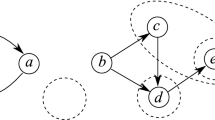Abstract
An axiomatics of the product-free syntactic calculus L ofLambek has been presented whose only rule is the cut rule. It was alsoproved that there is no finite axiomatics of that kind. The proofs weresubsequently simplified. Analogous results for the nonassociativevariant NL of L were obtained by Kandulski. InLambek's original version of the calculus, sequent antecedents arerequired to be nonempty. By removing this restriction, we obtain theextensions L 0 and NL 0 ofL and NL, respectively. Later, the finiteaxiomatization problem for L 0 andNL 0 was partially solved, viz., for formulas withoutleft (or, equivalently, right) division and an (infinite) cut-ruleaxiomatics for the whole of L 0 has been given. Thepresent paper yields an analogous axiomatics forNL 0. Like in the author's previous work, the notionof rank of an axiom is introduced which, although inessentialfor the results given below, may be useful for the expectednonfinite-axiomatizability proof.
Similar content being viewed by others
References
Buszkowski, W., 1987, “The logic of types,” pp. 213-221 in Initiatives in Logic, J. Srzednicki, ed., The Hague: Martinus Nijhoff.
Hendriks, H., 1993, Studied Flexibility: Categories and Types in Syntax and Semantics. ILLC Dissertation Series 1993-1995, Amsterdam: ILLC.
Janssen, T., 1991, “On properties of the Zielonka-Lambek calculus,” pp. 303-308 in Proceedings of the Eighth Amsterdam Colloquium, P. Dekker and M. Stokhof, eds., Amsterdam: ILLC, University of Amsterdam.
Kandulski, M., 1988, “The non-associative Lambek calculus,” pp. 141-151 in Categorial Grammars, W. Buszkowski, W. Marciszewski, and J. van Benthem, eds., Amsterdam: Benjamins.
Lambek, J., 1958, “The mathematics of sentence structure,” American Mathematical Monthly 65, 154-170.
Lambek, J., 1961, “On the calculus of syntactic types,” pp. 166-178 in Structure of Language and Its Mathematical Aspects, R. Jakobson, ed., Providence, RI: American Mathematical Society.
Moortgat, M., 1988, Categorial Investigations: Logical and Linguistic Aspects of the Lambek Calculus, Dordrecht: Foris.
van Benthem, J., 1991, Language in Action: Categories, Lambdas and Dynamic Logic, Amsterdam: North Holland.
Zielonka, W., 1981, “Axiomatizability of Ajdukiewicz-Lambek calculus by means of cancellation schemes,” Zeitschrift für Mathematische Logik und Grundlagen der Mathematik 27, 215-224.
Zielonka, W., 1988, “Cut-rule axiomatization of product-free Lambek calculus with the empty string,” Zeitschrift für Mathematische Logik und Grundlagen der Mathematik 34, 135-142.
Zielonka, W., 1989, “A simple and general method of solving the finite axiomatizability problems for Lambek' syntactic calculi,” Studia Logica 48, 35-40.
Zielonka, W., 1990, “Linear axiomatics of commutative product-free Lambek calculus,” Studia Logica 49, 515-522.
Zielonka, W., 1997, “More about the axiomatics of the Lambek calculus,” pp. 319-324 in Euphony and Logos. Essays in Honour of Maria Steffen-Batóg and Tadeusz Batóg, R. Murawski and J. Pogonowski, eds., Amsterdam: Rodopi.
Author information
Authors and Affiliations
Rights and permissions
About this article
Cite this article
Zielonka, W. Cut-Rule Axiomatization of the Syntactic Calculus NL0. Journal of Logic, Language and Information 9, 339–352 (2000). https://doi.org/10.1023/A:1008309805070
Issue Date:
DOI: https://doi.org/10.1023/A:1008309805070



